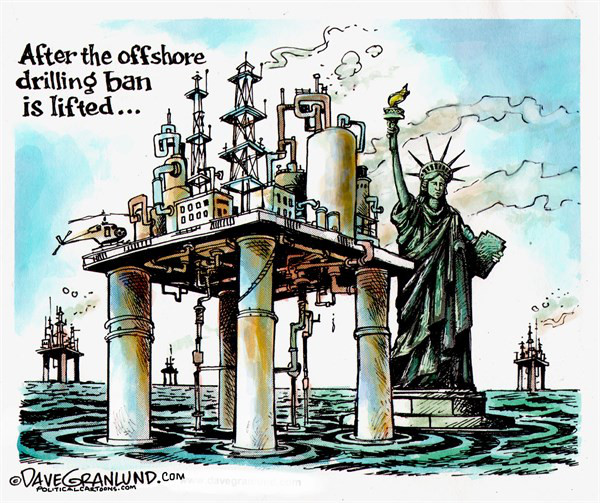Local Governments Must Oppose Fracking
Coalition Advocacy Can Be Very Effective

When we heard that Donald Trump wants to resume offshore oil drilling along Santa Barbara’s coastline, alarm bells went off on the Central Coast. Now that we know he wants to open nearly 273,000 acres to fracking (and oil drilling) across Santa Barbara, Ventura, and San Luis Obispo counties, it’s time for local government leadership advocacy. Municipalities in the three counties should form a coalition, invite diverse groups (environmental, environmental justice, and business) to join a coalition and carry out a high visibility campaign opposing the fracking.
Fracking is an extraction process that accesses deposits of shale gas and oil buried deep underground by injection large amounts of water mixed with toxic chemicals into wells to fracture the rocks that hide the gas and oil. It is an incredibly destructive process that requires large amounts of water mixed with as many as 600 toxic chemicals, many of which are known carcinogens (such as lead, uranium, radium, formaldehyde, hydrochloric acid, and mercury) to be successful. The environmental and health impacts include: pollution of water resources, releasing toxic chemicals into the air, greenhouse gas emissions, earthquakes, and the exacerbation of existing drought conditions.
This fracking push by the Trump administration is part of the oil and gas industry’s plan to launch another surge in activity and profits reminiscent of the 2014-2015 shale oil (fracking) explosion. What is insidious about it is that the administration and the industry know fracking is not a sustainable energy future for the country. It only produces short term gas and oil, and to remain profitable it must be consistently fed by opening new wells. According to researchers at the Post Carbon Institute, fracking shale “declines 70% to 90 % in the first three years.” Much like strip mining, fracking requires the opening of new deposits to maintain production and profits.
If the administration’s strategy succeeds we will see fracking adjacent to Lake Cachuma (79 percent of Santa Barbara’s water supply), at Vandenberg Air Force Base, and on previously protected National Forest lands in Santa Barbara County; adjacent to Lake Casitas (Western Ventura’s water supply), in Point Mugu State Park, and adjacent to Ojai’s Thatcher School in Ventura County; at Morro Rock in the entrance to Morro Bay Harbor and in Monte de Oro State Park in San Luis Obispo County. Other designated areas for the drilling would threaten the recovery of the endangered condor and reintroduced tule elk and pronghorn antelope in Ventura and San Luis Obispo counties, not to mention both terrestrial and marine recreational areas in all three counties.
It’s not just that fracking comes with environmental threats. On the Central Coast it could devastate our already fragile water sources. Water pollution aside, fracking requires pumping large amounts of water (1 million to 8 million gallons for each well) into the ground. The Central Coast is now in its eighth year of extreme drought, with climate scientists predicting drought as the “new normal” for our part of the world. Surface water supplies like Cachuma, Casitas, and the Santa Ynez River are already stressed and fully appropriated. The City of Santa Barbara is predicting water shortages as soon as 2020. These water sources cannot be used for fracking. What groundwater is left is sorely need to ensure drinking water supplies. Fracking water, if it could be found, would have to be purchased and imported by truck causing more air pollution, fossil fuel emissions, traffic, and noise. Surely, in any sane universe this would disqualify it in our part of the world. We are not, however, living in a sane world.
Coalition advocacy is by no means new. It can, however, be very effective. This column has previously suggested that the City of Santa Barbara take the lead in organizing Central Coast cities to oppose renewed offshore oil drilling. This kind of municipal led coalition requires that cities and counties acknowledge and embrace a needed new role: becoming leaders in advocating at the federal level for local concerns. In our 24/7 cable news and social media world it is no longer enough to just rely on elected officials, nonprofit groups, concerned individuals, and environmental lawsuits designed to delay decisions to combat large-scale industry and government assaults on local resources.
Today, for protest advocacy to be effective it must, like a sustained drum beat, consistently reach the “daylight” of media (social, TV, newspaper, and radio) attention. By itself, simply commenting and advocating within invisible-to-the-public bureaucratic structures is playing an “insiders” game on a field designed in favor of government and industry. Policy makers all too often rely on staff recommendations. Staff and policy makers all too often are impacted by the kinds of financial resources industry can invest in the hearing and comment process.
In a sane world, we would be continuing the push to increase renewable energy sources rather than promoting new fracked gas and oil fossil fuel extraction. Local governments have the “standing” and visibility to attract the kind of attention capable of influencing policy makers. This can only happen if they step outside of their traditional (and comfortable) role of legislating local ordinances and become leaders in national advocacy on issues like fracking that threaten their jurisdictions. If this doesn’t happen here, I am afraid that in this time of Trumpism, the proposed fracking projects will proceed on pace.



